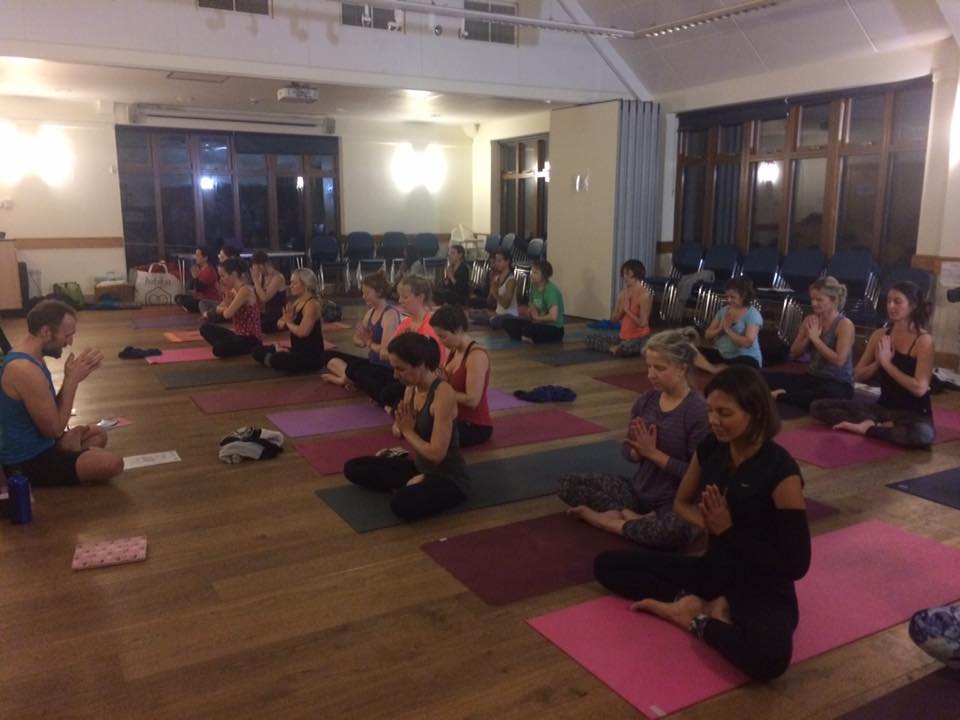What did you get up to last Sunday? If you were at Andy Gill’s workshop at The Yoga Hutch, hosted by fellow long-time senior teacher Sarah Vaughan, you would have learnt how to be a cat (whilst also being a dog); discovered how to make hands turn into feet, and witnessed the birth of an entirely new pose known as ‘Virabhadracula’. Oh, and you would have learnt to fly….
Andy Gill’s 10 years of teaching Astanga, and many years of Primary, Second and Third series practice, obviously make him a very experienced and knowledgeable teacher, but Andy brings something more to the mat. There’s a curiosity and playfulness to his approach, as well as a quiet strength and a sense of acceptance. These opposing forces beautifully personify the essence of bandha, the hub of this workshop’s exploration of floating, flying and hand-standing.
After bringing us together with a simple 12 breath practice, Andy led us, call and response style, through the teaching mantra. He then kicked off the workshop with a group discussion of the nature of bandhas; what they are, how to find them, and the qualities they bring to our practice. Regular Yoga Hutch students will be familiar with the friendly felines at the studio, and now we have another cat to add to the family – the slight ‘angry cat’ flexion of the spine when we ‘gather’ ourselves and connect with the bandhas to find the structure and stability which are the key to flying. It’s a subtle movement, quite distinct from the ‘tail-tucking’ which used to be popular in some quarters, but it engages the large transverse abdominus muscle which acts as a natural corset and is a crucial component of core stability, as well as the support of the internal organs and pelvis. This in turn means that front of the pelvis draws slightly upwards, which creates the start of the bandha, and redistributes the load of work a little further up the spine, creating lightness and lift-off. Of course some fear of flying is only natural, and partnering up gave us the opportunity to play with our new techniques with the security of someone making sure we couldn’t overshoot and face-plant. Andy and Sarah kept a watchful eye and provided us with plenty of support and individual advice, and very soon there were students taking to the air in all directions! A tea break fuelled by Sarah’s fabulous and super-healthy ‘chocolate truffle protein balls’ allowed more time for discussion, before coming back to mat for more exploration.
For me this subtle shift in alignment had the added bonus of suggesting a new approach to the backbends of second series, which will keep a body type like mine (tight hip flexors, mobile lower back, occasionally grumpy sacro-iliac joint) safe for decades to come. Andy’s suggestion of coming into Virabhadrasana 1 with palms facing backwards has also completely altered my relationship with the pose – the arm position has never felt great in my trapezius muscles, and Vira 1 and I were only ever going to be grudging acquaintances, until this slight tweak. All of a sudden I have space and freedom – and if that’s not exactly what we’re looking for in an asana practice, I don’t know what is!
After time spent playing with handstands, punctuated by plenty of delighted ‘ooh’ sounds as hands turned into feet, we came back together to close the practice with the teaching mantra – followed by lots of thanks and excited chatter as we floated back into the outside world.
Andy’s wonderfully open and non-dogmatic approach was to encourage us all to explore possibilities, try new things with a beginner’s mind, and find the methods that work for us as individuals. After all, he reminded us, yoga is an exploration, an experiential practice, a way to fully inhabit the present moment through the media of our bodies and breath…. and best of all, it’s fun!
